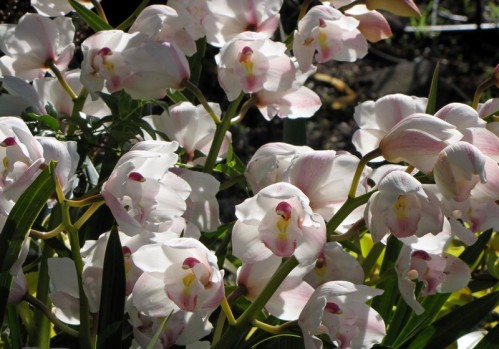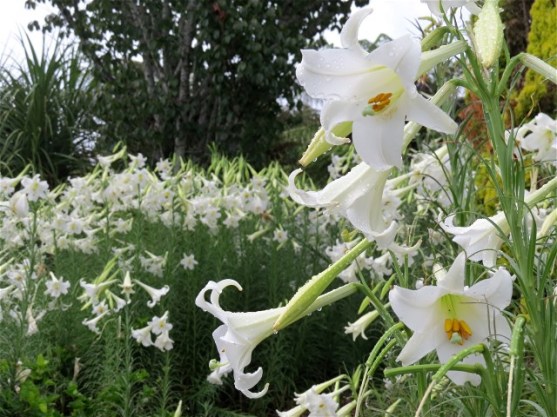A lifetime – two lifetimes – spent working with plants and flowers has taken a new twist as sisters Mary Parkinson and Jo Dawkins put their energies into helping develop Te Puna Quarry Park, the Western Bay’s premier public garden.

In 2005 I managed to get these two busy bees to stand still long enough for a photo. They haven’t changed much. Photo: Sandra Simpson
Born on a farm in Oropi, near Tauranga, the sisters grew up surrounded by a large, lovingly tended garden. Their father, Arnold Shanks, had emigrated to New Zealand from Northern Ireland and met their England-born mother, Christine, on a ship when returning to Britain on a visit. She was going home after a stay in South Africa.
And it was their father who was the keen gardener, although they say both their parents loved “beautiful things” and the home and garden were decorated accordingly.
Volunteering at the outbreak of World War 2, Arnold was sent to Greece, captured and spent four years in an Austrian prison camp. “He said the only thing that kept him sane was thinking about the garden and always redesigning it,” Jo says. “He had a small tin of watercolour paints with him and we still have some of the paintings he did of his ideas. The love of gardening kept him going.” The 0.4ha garden comprised a tennis court, lily ponds and flower beds and was the scene of annual church garden parties after the war.

A visitor from England snaps a souvenir of one of the Quarry Park’s many sculptures. Photo: Sandra Simpson
Mary’s first ambition was to become a marine biologist, dropped, she says, because she couldn’t swim well. Instead, she opened a florist shop at No. 2 Devonport Rd in Tauranga in 1956. “The shop became available and opportunity strikes only once, although I was terrified about going into business,” she says. And it may have been an inherited talent from her father – who had created his bride’s elaborate bouquet for their wedding in 1933 – which nudged her in this direction.
Vogue Flowers was a success, although Mary says “we made a lot of friends but not much money”. Highlights included making presentation bouquets for visiting Queen Sirikit of Thailand in 1962 and one of water lilies for Queen Elizabeth for her visit in 1963.
When their mother became ill with cancer and wanted to make a final return to England in 1958, Mary handed the business to Jo, who was part-way through teacher training. After her mother’s death, Mary worked as a florist at London’s Savoy Hotel where she prepared arrangements for such people as Princess Margaret, ballerina Alicia Markova and flamboyant pianist Liberace who always wanted a floral grand piano.
While in London, she attended the Cordon Bleu school run by the doyenne of 1950s English domestic style, Constance Spry. “We cooked in the morning and did flowers in the afternoon,” Mary recalls. “They were big, massed arrangements which complemented the houses they were in.”
On her return, Mary rejoined Vogue Flowers until the birth of her first child in 1963, when she sold the business.
But she and Jo have never stopped working with plants – they both worked for John and Mary Ewart when they began to grow Tauranga’s first commercial carnation crop, while Mary has had a nursery specialising in kiwifruit seedlings, and Jo has a citrus orchard and garden nursery.
“There’s a lot of pleasure to be had in planting a seed and watching it come up and flower,” Mary says of their lifelong interest in growing things.

Cymbidium orchids blooming at the Quarry Park. Photo: Sandra Simpson
She is also something of an orchid expert, having joined the Tauranga Orchid Society 30 years ago and also has previously run a business hybridising and exporting South African disa orchids.
But even Mary admits she had no idea the orchid area at Te Puna Quarry Park would become what is believed to be the largest outdoor planting of cymbidium orchids in the Southern Hemisphere.
Jo, whose home is in the shadow of the former quarry north of Tauranga, has been part of the community project since it began almost 20 years ago and has served a term as president of the society’s committee, while Mary joined the volunteer workers 18 years ago.
“It’s great to be part of a volunteer group creating something for the community,” Jo says. The park has always placed an emphasis on art too, and work in the park includes sculpture, mosaic and pottery.
“It’s such a magical place,” she says, “but it was very hard in the beginning, as a gardener, to adjust to the size of it. It was no good planting just one of something, we had to think in big drifts.” More than 4000 cymbidium orchids might be described as a big drift. “We were lucky the orchids were the first plants to arrive and we could choose a site,” Mary says.
Four truckloads of “fill” orchids, donated by former nurseryman John Kenyon, began the planting and since then almost all the plants have been donated. To plant them on the steeper banks, the orchids were rolled down and Mary and her helpers (most in their 70s and 80s) clambered after them and chipped them in where they stopped. The orchid area now features several other varieties as well, so there’s always something flowering.
These days Mary’s most often to be found in the butterfly garden, a project that had its genesis in 2006 when she saw a swan plant growing in a patch of weeds on the “middle terrace”.
A grant from the Bay of Plenty regional council’s Environmental Enhancement Fund paid for a butterfly hatching house (and to protect caterpillars when predators are about) and a noticeboard, while in 2009 Wildflower World began a relationship with the garden donating seed to extend the butterfly area for a Monarch Butterfly New Zealand Trust conference in Tauranga which Mary, then a trustee, organised.

A release of newly hatched monarch butterflies in the Quarry Park’s butterfly garden. Photo: Sandra Simpson
During the breeding season Mary often responds to calls to rescue monarch caterpillars that have run out of food and has been trying try to establish a population of native red admiral and yellow admiral butterflies at the quarry. She’s at the quarry most days when the butterflies are hatching, and on hand for regular school visits. “When the ‘wild kids’ are given butterflies to hold it transforms them – the big smiles make it all worthwhile,” she says.
Jo, a former president of the International Plant Propagators Association, and Mary have developed a sub-tropical area, bounded on one side by Australian natives, including a prostate Banksia and winter-flowering grevilleas, much loved by birds, and on another by South African natives.
And they have both, along with grandchildren, created a mosaic “pool” at the bottom of a tumble of rocks which suggested itself to Jo as a dry waterfall. Small wooden “bridges” on the path add to the illusion.
Among plants of interest in this area are Chorisias (monkey no-climb trees) with trunks full of thorns and requiring some lateral thinking when it came to moving them for planting, a red banana palm and a rare pink version (in New Zealand) of the Tibouchina shrub.

A massed planting of lilies above the Herb Garden. Photo: Sandra Simpson
Jo has planted about five varieties of the Araucaria family, which includes monkey-puzzle and Norfolk Island pines, near the Chorisias, and groups of maples and magnolias in a new area, as well as a tackling a steep, hot bank which is being filled with grevilleas, native to Australia.
“We are especially grateful for the generosity of commercial and private growers,” Jo says. “We don’t have the finances to rush out and buy, for example, 50 hibiscus plants, but if we ask for, say, three we usually get 12.
“The quarry park isn’t a botanical garden, but we do want it to be botanically interesting,” she says. “The rewards for our hard work are to see people enjoying it.”
Te Puna Quarry Park is signposted off State Highway 2, just north of Te Puna, and is open daily during daylight hours. Free admission but a donation is appreciated.

A tui investigates a protea bloom. Photo: Sandra Simpson
This article is a combination of two pieces that were originally published by the Bay of Plenty Times and appear here with permission.
